
 |
Between August 13 and 15, when summer in Japan is at its
height, offices and businesses give their employees a holiday timed to coincide with the observance of O-Bon. Second only to New Year's, O-Bon is a major annual event that brings families and relatives together, even when they live in distant parts of the country. As a result, O-Bon is invariably a time when people move about a great deal, traveling
either domestically or overseas. For school children, O-Bon comes about halfway through the school summer vacation. People who live in the city often use this holiday to take their families back to the rural homes of grandparents or relatives, to travel around Japan or even go overseas. Trains, airplanes, and other forms of transportation are invariably overcrowded and the expressways clogged with traffic jams. For school children, O-Bon comes about halfway through the school summer vacation. People who live in the city often use this holiday to take their families back to the rural homes of grandparents or relatives, to travel around Japan or even go overseas. Trains, airplanes, and other forms of transportation are invariably overcrowded and the expressways clogged with traffic jams. In this issue, we look at how people spend this holiday that is the symbol of the Japanese summer, introducing the stories of elementary, junior, and senior high school students. In this issue, we look at how people spend this holiday that is the symbol of the Japanese summer, introducing the stories of elementary, junior, and senior high school students. |
|
What is O-Bon? O-Bon marks the convergence of a Buddhist ritual for the dead ( the word has its roots in the Sanskrit word ullambana ) with indigenous folk rituals to the ancestors praying for the health and prosperity of the household. Traditionally it is believed that the spirits of the ancestors revisit ancestral homes during midsummer, and people take this occasion to pay their respects to family graves. A mukaebi  ( welcoming fire ) is kindled at the beginning of O-Bon and offerings are made in homes with household Buddhist altars. O-Bon observances end with the lighting of okuribi ( welcoming fire ) is kindled at the beginning of O-Bon and offerings are made in homes with household Buddhist altars. O-Bon observances end with the lighting of okuribi  ( farewell fires ). Family and relatives gather together, enjoy each other's company while honoring the spirits of those who came before them, and then all go their separate ways. This tradition is celebrated by some in Tokyo and other big cities around July 15th, in accordance with the lunar calendar which was officially replaced by the solar ( Western ) calendar in 1872. ( farewell fires ). Family and relatives gather together, enjoy each other's company while honoring the spirits of those who came before them, and then all go their separate ways. This tradition is celebrated by some in Tokyo and other big cities around July 15th, in accordance with the lunar calendar which was officially replaced by the solar ( Western ) calendar in 1872.
|
|
Summer holiday : Longest vacation in the school year Summer holiday in the Japanese school year extends for about 40 days from July 20 to August 31. ( In Hokkaido, Japan's northernmost region, it is slightly shorter, and in Okinawa, its southernmost region, the vacation is slightly longer. ) The school year begins in April, and the first semester stretches until July. Summer vacation comes midway through the school year. There is a two week vacation in late December and early January and two weeks off in late March, but summer vacation is the longest holiday.  There are no classes during the summer, but most schools provide special classes in swimming, and junior and senior high school sports and other recreation clubs meet almost every day for practice or projects. Schools almost always assign "summer homework," which is supposed to be submitted when classes resume in September. Third year junior and senior high school students planning to take competitive entrance examinations usually spend the summer vacation studying, either independently or at juku ( special study schools ). Many juku have special intensive classes during the summer. There are no classes during the summer, but most schools provide special classes in swimming, and junior and senior high school sports and other recreation clubs meet almost every day for practice or projects. Schools almost always assign "summer homework," which is supposed to be submitted when classes resume in September. Third year junior and senior high school students planning to take competitive entrance examinations usually spend the summer vacation studying, either independently or at juku ( special study schools ). Many juku have special intensive classes during the summer. As the summer continues after O-Bon, the climate changes gradually and the typhoon season begins. By then, however, it's time to get cracking on your summer homework! As the summer continues after O-Bon, the climate changes gradually and the typhoon season begins. By then, however, it's time to get cracking on your summer homework!
|
Working people's summer holiday Most working people in Japan take off an average of 3.8 days during the summer except for weekends. Recently, companies have begun to allow employees to take their holidays individually, at their own discretion, but factories usually expect workers to take time off all at once, such as during the week or so surrounding O-Bon holiday. In Japanese society, where people need to be constantly conscious of the convenience of their employers and co-workers, it is not easy to take time off whenever they wish. O-Bon, however, is an acceptable time to take a holiday. |
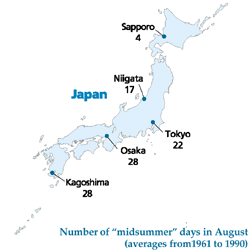 The Japanese summer
The Japanese summerJapan's climate is known for its frequent seasonal changes, and when the monsoon rains that sweep over the archipelago from mid-June to early July finally come to an end, high pressure areas move over the Pacific Ocean, plunging the country into the heat of summer. August is the hottest month of the year, and although there are differences between northernmost Hokkaido and southernmost Kyushu and Okinawa, the entire archipelago is assaulted with " fierce heat " ( moosho  ). So-called manatsubi ). So-called manatsubi  or " midsummer days " in August, when the temperature is 30 degrees or over are shown in the table for different parts of the country. or " midsummer days " in August, when the temperature is 30 degrees or over are shown in the table for different parts of the country. Not only is the temperature high, so is the humidity. Weather reports cite what is called the " discomfort index " ( fukai shisu Not only is the temperature high, so is the humidity. Weather reports cite what is called the " discomfort index " ( fukai shisu  ) calculated on the basis of temperature and humidity. When this index rate goes over 75, more than half of people feel uncomfortable, when it goes over 80, everyone is uncomfortable. The fact that indices like these become the stuff of television and radio news is an indication of the severe heat of Japan's summers. ) calculated on the basis of temperature and humidity. When this index rate goes over 75, more than half of people feel uncomfortable, when it goes over 80, everyone is uncomfortable. The fact that indices like these become the stuff of television and radio news is an indication of the severe heat of Japan's summers.
|
People Spend Their O-Bon Holidays
|
|
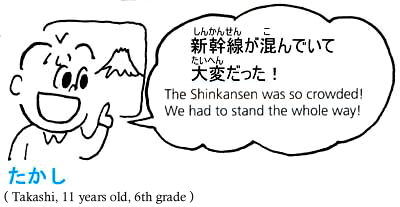 |
Takashi went with his family by Tokaido Shinkansen superexpress train to visit his grandmother in Shizuoka. The terminal at Tokyo Station was clogged with people on their way out of the city (kisei rasshu ). Every seat on every train was full, so they had to stand. They had bought eki-ben ( boxed lunches sold at the station ) to eat on the way. After the train stopped and some people got off, a seat opened up, and they all took turns sitting down to eat their lunch. From the windows of the train they could see the ocean on one side and Mt.Fuji on the other. |
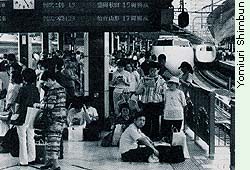 Tokyo Station during the holiday exodus ( kisei rasshu ), on the Shinkansen platform |
 kisei rasshu kisei rasshuMany people who now live in big cities like Tokyo and Osaka come from homes in the countryside, where their parents or grandparents still live. The exodus that occurs from the cities at O-Bon when they head back to their hometowns, causing severe overcrowding of stations and airports, is called kisei rasshu, " the going-home-to-the-country rush. " Trains are standing-room-only and airplanes are fully booked. Getting tickets is often very difficult. Fifty-to sixty-kilometer-long traffic jams are common on the main expressways and trunk roads. |
 eki-ben eki-benOne of the pleasures of traveling by train in Japan is buying eki-ben, locally made boxed lunches sold in the stations. Many stations'eki-ben feature local specialties that give travelers a real sense of being on a journey away from home. |
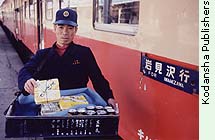 |
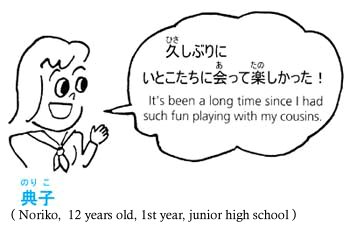 |
Relatives came to visit Noriko's home in Nagano prefecture for O-Bon. The house was filled with the fun and sounds of many people, her grandmother and the families of her father's older and younger brothers. They all went to visit the family grave where her grandfather, who died three years ago, and generations of ancestors are buried. They placed offerings on the Buddhist altar in the house. Grandmother sliced pieces of watermelon, and recalling that "Grandfather really liked watermelon," took them to place on the altar in remembrance. All the cousins and aunts and uncles sat together eating watermelon there, too. In the evening, the cousins had fun with sparklers and small fireworks in the garden. |
 haka-mairi ( visiting the graves ) haka-mairi ( visiting the graves )During the days of O-Bon, people visit their family graves, clean and tidy them, and decorate them with chrysanthemums and other flowers. ( Because chrysanthemums are so often used for funerals, to decorate graves, and offer at household altars, it is customary not to take bouquets of chrysanthemums when visiting or bringing flowers to people who are sick. )  butsudan ( household Buddhist altar ) butsudan ( household Buddhist altar ) osonae-mono ( offerings ) osonae-mono ( offerings )Cakes, fruit, and flowers are the standard offerings, but often include foods or sweets the deceased were fond of.  hanabi ( fireworks ) hanabi ( fireworks ) During summer, large-scale fireworks displays conducted by professionals are held regularly at various seaside and riverside locations, but enjoying small hand-held sparklers and low-risk fireworks in backyards and local parks is also very popular. During Japan's hot, humid summers, this is one of children's greatest pleasures in the evening cool. |
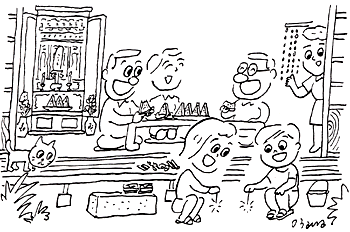 Offerings of watermelon at the butsudan while the assembled relatives eat the same summer treat. In the garden outside the children are lighting sparklers. |
 | ||
| Yusuke : I went to Miyazaki to visit my cousin. We had fun playing by the sea. | Ryota : We went to Shonan beach because it's close to my home in Tokyo, but it was really crowded. | |
Can you figure out what Yusuke did during O-Bon? Follow the picture diary.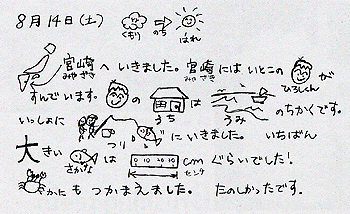 |
A crowded beach on the Shonan coast,one of the best-known seaside resorts in Japan. Within an hour by train from Tokyo, it is a popular gathering place for young people.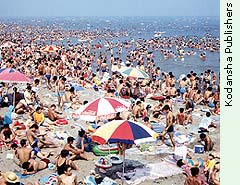 |
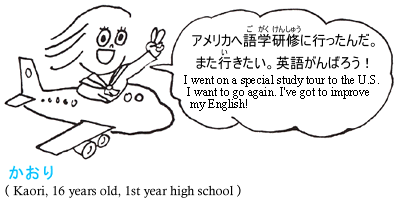 Kaori spent her summer vacation on a three-week language-study trip to the United States. Since it was her first experience overseas, the trip was full of surprises and discoveries: the vastness of the landscape, the easy-going nature of many people she met. Until then, she had been confident that she understood just about everything she heard and saw, but after traveling outside Japan, she learned that there were many things she did not know about and never would have imagined. Staying with an American family, she realized how inadequate her English ability was. Even though she had studied English for four years in Japan, when she tried talking to Americans, she found it almost impossible to put what she wanted to say into words. It was very frustrating. Her host family was very kind and she had wonderful time. She really regrets that she was not able to communicate with them better. Back in Japan, she is determined to study English harder and learn more about the culture that
is behind it. Kaori spent her summer vacation on a three-week language-study trip to the United States. Since it was her first experience overseas, the trip was full of surprises and discoveries: the vastness of the landscape, the easy-going nature of many people she met. Until then, she had been confident that she understood just about everything she heard and saw, but after traveling outside Japan, she learned that there were many things she did not know about and never would have imagined. Staying with an American family, she realized how inadequate her English ability was. Even though she had studied English for four years in Japan, when she tried talking to Americans, she found it almost impossible to put what she wanted to say into words. It was very frustrating. Her host family was very kind and she had wonderful time. She really regrets that she was not able to communicate with them better. Back in Japan, she is determined to study English harder and learn more about the culture that
is behind it. |
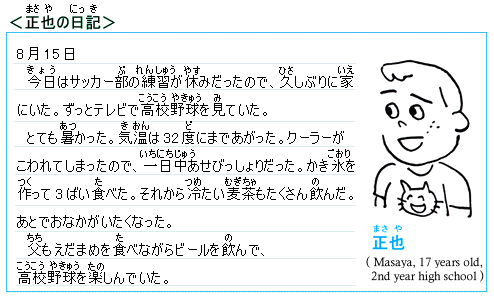 | |
| From Masaya's diary | |
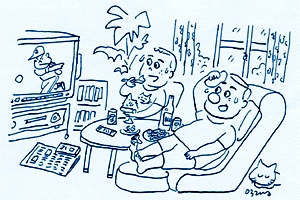 | August 15 Today we had off from soccer club practice, so I was at home all day for a change. Spent the whole day watching the high school baseball tournament games on television.  It was awful hot. Temperature went up to 32 degrees. Something's wrong with the air conditioner, so we were drenched in sweat all day. I ate three bowls of kakigoori and drank who knows how many glasses of mugicha. No wonder I got a stomach ache later on. It was awful hot. Temperature went up to 32 degrees. Something's wrong with the air conditioner, so we were drenched in sweat all day. I ate three bowls of kakigoori and drank who knows how many glasses of mugicha. No wonder I got a stomach ache later on.  Father was home too, watching the high school baseball, drinking beer and munching on eda-mame. Father was home too, watching the high school baseball, drinking beer and munching on eda-mame. |
 bukatsudo ( club activities ) bukatsudo ( club activities )After-school clubs at junior and senior high schools are very active even during summer vacation. Taking advantage of the time for extra practice in preparation for tournaments or big competitions, sports clubs often hold intensive-practice camps during the summer. The brass band and chorus clubs, too, practice hard for upcoming performances.  kookoo yakyuu ( high school baseball ) kookoo yakyuu ( high school baseball )Baseball remains the favorite sport of Japanese. The National Invitational Senior High School Baseball Tournament ( spring ) and the All-Japan High School Baseball Championship Tournament ( summer ) are nationally broadcast and people root for teams from their home prefecture or locale; the final rounds of games are played at Kooshien Stadium in Hyogo prefecture ( near Kobe ).  natsu no Kooshien ( the summer Kooshien tournament ) natsu no Kooshien ( the summer Kooshien tournament ) The summer tournament begins with prefectural competitions and the winning teams gather at the Kooshien stadium in August to compete for the championship. Much of the excitement of this tournament coincides with the O-Bon holidays. |
 kakigoori ( shaved ice ) kakigoori ( shaved ice )Shaved ice flavored with sweet syrup, a popular summer snack. Many people make it at home with simple ice-shaver equipment.  mugicha ( barley tea ) mugicha ( barley tea )Tea made from unhulled, roasted barley. The roasted barley is boiled and steeped, then chilled. A mild, unsweetened beverage, it satisfies the thirst of Japan't hot summers.  biiru to eda-mame ( beer and boiled green soybeans ) biiru to eda-mame ( beer and boiled green soybeans ) People drink more beer in the summertime, often with the seasonal eda-mame. Eda-mame are soybeans picked while they are still bright green and soft. They are boiled in the pod in salt water and eaten out of the pod. |
 | |
| Yumi : Summer break would be the greatest, if only there weren't any homework. | Shinji : What are you dreaming about! Look at me. I'm going to juku classes every day to get ready for the college entrance exams. I've got mock tests and all. Life is tough for jukensei ( students studying for entrance examinations ) -- no summer vacation for us! |
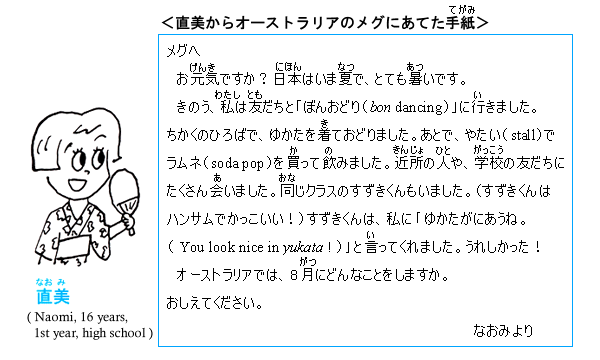 |
| A letter to Meg, my Australian penpal | |
| Dear Meg, How are you? It's summer in Japan now and extremely hot. Yesterday I went to the bon-odori with my friends. We wore yukata to dance at the public square nearby.  After some dancing, we went to the stalls and got ramune soda pop in glass bottles to quench our thirst. Suzuki-kun, who is in my class ( a very handsome and cool guy! ) was there too. Suzuki-kun said " You look nice in yukata. " Wow, did that make me happy! After some dancing, we went to the stalls and got ramune soda pop in glass bottles to quench our thirst. Suzuki-kun, who is in my class ( a very handsome and cool guy! ) was there too. Suzuki-kun said " You look nice in yukata. " Wow, did that make me happy!  What special events do you have in August in Australia? Please tell me about them. What special events do you have in August in Australia? Please tell me about them.  from Naomi from Naomi |
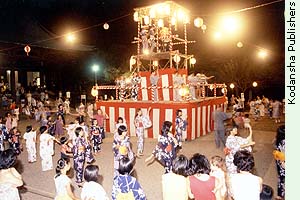 Dancing bon-odori in yukata. |
 bon-odori bon-odoriOne of the events that customarily accompany the season of O-Bon is the holding of bon-odori dancing. In public open spaces -- school athletic fields, shrine precincts, station plazas -- communities build a yagura platform from which music is played. Today taped music is usually played through loudspeakers, but often with accompaniment by live drums ( taiko ) and sometimes pipes ( fue ). People dance in a circle around the platform. Originally the dances were held to welcome the spirits of the ancestors back to the world of the living during O-Bon, to honor and entertain them, and then to send them off again to the spirit world. Today, however, the religious meaning of the dances has faded, and the purpose is rather to help the members of a community get to know each other and strengthen their bonds. Urban housing complexes often hold bon-odori as summertime events that can help to enhance community solidarity. |
 yukata yukataMany people dress up in yukata, informal cotton kimono with simple sash, when they participate in bon-odori. Recently yukata has become fashionable among young women. |
| Original text : The Japan Forum Newsletter no13 "A day in The Life" June 1999. |
Send feedback to forum@tjf.or.jp